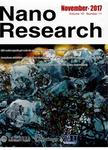Energy harvesting model of moving water inside a tubular system and its application of a stick-type compact triboelectric nanogenerator
Energy harvesting model of moving water inside a tubular system and its application of a stick-type compact triboelectric nanogenerator作者机构:Department of Mechanical Engineering Pohang University of Science and Technology (POSTECH) 77 Cheongam-ro Pohang Gyeongbuk 790-784 Republic of Korea School of Mechanical Engineering Chung-Ang University 84 Heukseok-ro Dongjak-gu Seoul 156-756 Republic of Korea
出 版 物:《Nano Research》 (纳米研究(英文版))
年 卷 期:2015年第8卷第8期
页 面:2481-2491页
核心收录:
学科分类:080801[工学-电机与电器] 090704[农学-森林经理学] 0808[工学-电气工程] 0907[农学-林学] 08[工学] 09[农学]
基 金:supported by the National Research Foundation of Korea (NRF) grant funded by the Korea government (MSIP) supported by Basic Science Research Program through the National Research Foundation of Korea (NRF) funded by the Ministry of Education supported by the Human Resource Training Program for Regional Innovation through the Ministry of Education and National Research Foundation of Korea
主 题:contact electrification triboelectric nanogenerator anodized aluminum xide superhydrophobic tubular system compact design
摘 要:As the first invention to efficiently harvest electricity from ambient mechanical energy by using contact electrification, the triboelectric nanogenerator has elicited worldwide attention because of its cost-effectiveness and sustainability. This study exploits a superhydrophobic nanostructured aluminum tube to estimate electrical output for solid-water contact electrification inside a tubular system. The linearly proportional relationship of short-circuit current and open-circuit voltage to the detaching speed of water was determined by using a theoretical energy harvesting model and experimentation. A pioneering stick-type solid-water interacting triboelectric nanogenerator, called a SWING stick, was developed to harvest mechanical energy through solid-water contact electrification generated when the device is shaken by hand. The electrical output generated by various kinds of water from the environment was also measured to demonstrate the concept of the SWING stick as a compact triboelectric nanogenerator. Several SWING sticks were connected to show the feasibility of the device as a portable and compact source of direct power. The developed energy harvesting model and the SWING stick can provide a guideline for the design parameters to attain a desired electrical output; therefore, this study can significantly increase the applicability of a water-driven triboelectric nanogenerator.



